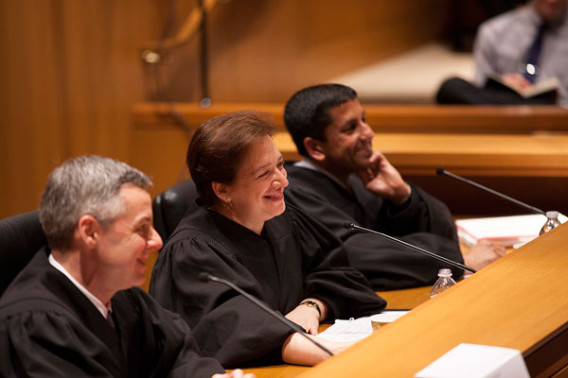Supreme Court Justice Elena Kagan presides over Stanford Law School’s Moot Court final arguments

A sterling reputation is the key driver of success for lawyers, agreed U.S. Supreme Court Justice ELENA KAGAN and U.S. Circuit Judges SRI SRINIVASAN and RAYMOND KETHLEDGE during a recent conversation at Stanford Law School.
The event, presented by the American Constitution Society and the Federalist Society, was held prior to this year’s Moot Court Board final arguments, at which the justice and judges presided as a simulated U.S. Supreme Court.
It was a homecoming for Srinivasan, who was a Moot Court finalist when he attended Stanford Law School. Law Professor JEFFREY FISHER, who has argued 26 times before the high court and is co-director of the Stanford Supreme Court Litigation Clinic, served as moderator.
Asked what made them first aspire to become judges, all three referred to their experiences as law clerks, the trusted relationships they made during their careers and unexpected opportunities that came along. Kethledge noted that he and Srinivasan became friends when they clerked together at the Supreme Court, and later helped each other when they were nominated as judges. Srinivasan mentioned also clerking alongside M. ELIZABETH MAGILL, now dean of Stanford Law School, who welcomed everyone to the event.
“I’m feeling like the odd man out,” quipped Kagan. “It sounds like everyone has clerked together but me. But that’s OK because I get to be the Chief Justice.” Kagan was referring to her role as Chief Justice during the Moot Court competition. In her real-life role on the Supreme Court, she is the junior justice who, by tradition, takes notes for the group and answers when there are knocks on the door during closed sessions.
Recounting the unexpected twists in her career, Kagan said most law students plan too much and don’t take into account the times when “lightning strikes.”
“The best thing is not to plan, but to work hard and be a good person. In the end that’s what gets you the opportunity,” she advised.
Kagan, Srinivasan and Kethledge also talked about what it takes to be a good law clerk, how to write a solid legal brief and what makes a sound legal argument. Later, they praised Stanford law student finalists who argued at the Moot Court finals.
Read the full story on Stanford Law School’s blog.
Terry Nagel is associate director of media relations for Stanford Law School.

